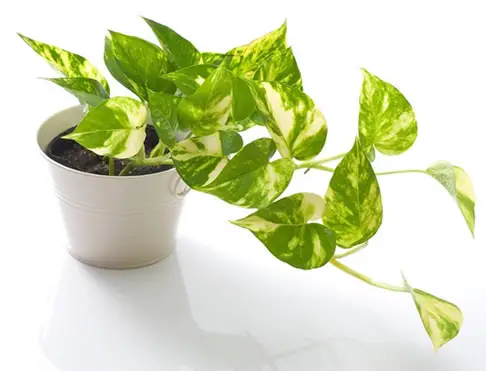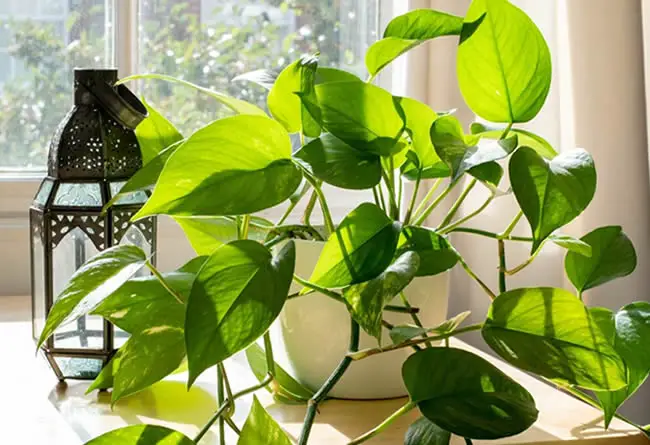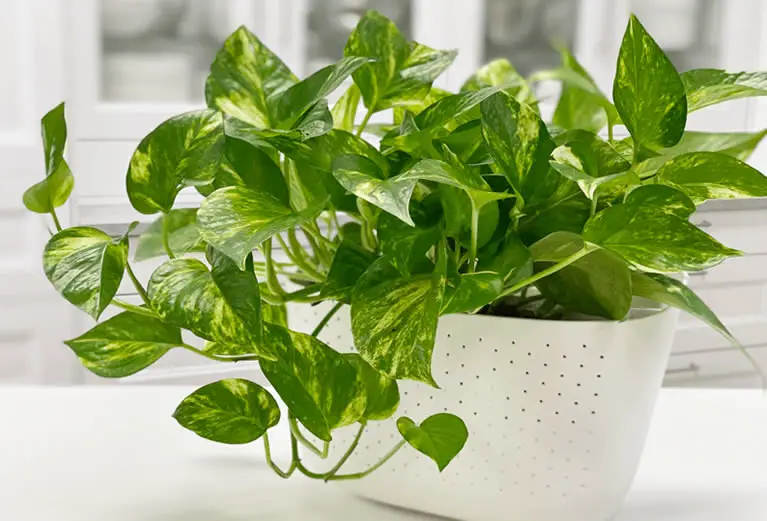Golden Pothos (Epipremnum aureum), also called Devil’s Ivy, is one of the most popular and reliable houseplants you can grow. With its cascading vines and marbled green-and-gold leaves, it adds instant texture and color to any room. It’s incredibly low-maintenance, fast-growing, and forgiving—perfect for beginners or anyone who wants a plant that practically grows itself.
Here’s everything you need to know about caring for Golden Pothos indoors, from lighting to propagation, plus how to troubleshoot the most common issues.
Table of Contents
- How to Provide the Right Lighting Indoors
- Best Practices for Watering Your Golden Pothos
- Caring for Pothos Grown in Water
- Temperature and humidity
- Fertilizing needs of your Golden Pothos
- Repotting when necessary
- Pruning and shaping your Golden Pothos
- Pothos Propagation
- Best spot in the house for a Golden Pothos plant
- Common Golden Pothos Problems and How to Fix Them
- Final Thoughts
How to Provide the Right Lighting Indoors
Golden Pothos thrives in bright, indirect light, but it’s incredibly tolerant of lower light conditions as well.
It can grow in medium or even low light, though its variegation may fade and growth may slow down.
Direct sunlight should be avoided, as it can scorch the leaves and cause them to turn pale or crispy.
Best Practices for Watering Your Golden Pothos
Use a well-draining, all-purpose indoor potting mix.

Water when the top inch or two of soil feels dry.
Pothos prefers a cycle of thorough watering followed by drying out slightly.
Avoid letting the plant sit in water, as soggy soil can lead to root rot.
If you’re not sure whether it needs water, it’s usually better to wait a day or two.
Caring for Pothos Grown in Water
Golden Pothos can be grown in water alone!
Just ensure the roots are submerged and change the water every couple of weeks to keep it fresh and oxygenated.
Temperature and humidity
Golden Pothos grows best in temperatures between 60°F and 85°F.
It tolerates a range of household humidity levels but prefers moderate humidity if possible.
It’s not picky—dry winter air won’t bother it much, but misting occasionally can help if the leaf tips start to brown.
Fertilizing needs of your Golden Pothos
Feed every 4 to 6 weeks during spring and summer with a balanced liquid fertilizer diluted to half strength.
Use a good quality 10-10-10 fertilizer, like this feed.
Skip fertilizing in fall and winter when the plant’s growth naturally slows.
Repotting when necessary
Pothos doesn’t need frequent repotting but will benefit from fresh soil every year or two.
When roots begin to coil tightly in the pot or poke out of the drainage holes, move the plant into a slightly larger container with fresh soil.
Pruning and shaping your Golden Pothos
To encourage bushier growth or control long vines, simply trim back stems just above a node (the bump where a leaf grows).
You can prune regularly to keep it compact or let it trail freely for a fuller, cascading look.
Pothos Propagation
Golden Pothos is one of the easiest plants to propagate.
Take stem cuttings just below a node and place them in water or moist soil.
If rooting in water, wait until roots are a few inches long before planting them in soil.
Best spot in the house for a Golden Pothos plant
Golden Pothos is wonderfully versatile and can grow just about anywhere indoors.

It’s perfect for bedrooms, bathrooms, kitchens, or offices, especially in hanging baskets or on high shelves where the vines can trail naturally.
Common Golden Pothos Problems and How to Fix Them
Yellow leaves
This is often a sign of overwatering or poor drainage. If the soil is staying too wet, roots may be rotting.
Fix it by letting the soil dry out more between waterings and making sure your pot has drainage holes.
Wilting leaves
If the leaves droop, check the soil—too dry or too wet can both cause wilting.
Fix it by adjusting your watering rhythm. If the soil is dry, give it a deep soak.
If it’s wet, let it dry out completely before watering again.
Brown leaf tips or edges
This may be due to underwatering, low humidity, or salt buildup from fertilizer.
Fix it by watering consistently, using filtered water if needed, and occasionally flushing the soil with fresh water to clear out salts.
Leggy growth with long gaps between leaves
This is a sign that the plant isn’t getting enough light.
Fix it by moving the plant to a brighter spot with filtered light. You can also prune the leggy stems to encourage bushier growth.
Pale or faded variegation
Low light can cause the golden streaks to fade or disappear.
Fix it by moving your pothos closer to a window with bright, indirect light.
Pests like mealybugs or spider mites
While not common, pothos can occasionally attract pests, especially in very dry or dusty conditions.
Fix it by wiping leaves with a damp cloth and treating infestations with neem oil or insecticidal soap.
Final Thoughts
Golden Pothos is the ultimate easy-care houseplant.
It adapts to nearly any space, tells you when it needs something, and bounces back from the occasional mistake.
Whether you want a trailing jungle look or a clean, sculptural plant for a bookshelf, this beauty always delivers—no green thumb required.
Let me know what you’d like next, or if you’d like a version of this formatted for a printable guide or plant card! 🌿

